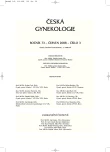Etiopathogenesis of Uterine Fibroid: Current Knowledge
Authors:
O. Sosna; D. Kužel; M. Mára
Authors‘ workplace:
Gynekologicko-porodnická klinika 1. LF UK a VFN, Praha, přednosta prof. MUDr. A. Martan, DrSc.
Published in:
Ceska Gynekol 2008; 73(3): 184-187
Overview
Objective:
To sum up the knowledge of etiology and pathogenesis of uterine fibroids.
Type of study:
Review.
Setting:
Department of Obstetrics and Gynaecology, 1st Faculty of Medicine, Charles University, Prague.
Subject of study:
A summary of what is known about development of uterine fibroids.
Conclusion:
In this overview of etiology and pathogenesis of uterine fibroids we have attempted to ananlyze the literature and present prevailing evidence and opinions.
Key words:
uterine fibroid, leiomyoma, risk and growth factors, initiators of tumorigenesis.
Sources
1. Al Hendy, A., Salama, SA. Catechol -O - methyltransferase polymorphism is associated with increased uterine leiomyoma risk in different ethnic groups. J Soc Gynecol Incest, 2006, 13, p. 136-144.
2. Arci, A., Sozen, I. Transforming growth factor beta 3 is expressed at high levels in leiomyoma where it stimulates fibronectin expression and cell proliferation. Fertil Steril, 2000, 73, p. 1006-1011.
3. Deligdisch, L. Hormonal pathology of the endometrium. Mod Pathol, 2000, 13, p. 285-294.
4. Dixon, D., Hasseman, J., et al. Imunohistochemical localization of growth factors and their receptors in uterine leiomyomas and matched myometrium. Environ Health Perspect, 2000, 108, p. 795-802.
5. Flake, GP., Andersen, J., Dixon, D. Etiology and pathogenesis of sterine leiomyomas: a review. Environ Health Perspect, 2003, 111, 8, p. 1037-1054.
6. Gross, K., Morton, C. Genetics and the developement of fibroids. Clin Obstet Gynecol, 2001, 44, p. 335-349.
7. Hanney, AF. Clinical decision making regarding leiomyomata: What we neder in the next millenium. Environ Health Perspect, 2000, 108, 5, p. 835-839.
8 Chiaffarino, F., Parazzini, F., La Vecchia, C., et al. Diet and uterine myomas. Obstet Gynecol, 1999, 94, p. 395-398.
9. Ligon, A., Morton, C. Genetic of uterine leiomyomata. Genes Chromosomes Cancer, 2000, 28, p. 235-245.
10. Marshall, LM., Spiegelmann, D., Goldman, MB., et al. A prospective study of reproductive factors and oral contraceptive use in relation to the risk of uterine leiomyomata. Fertil Steril, 1998, 70, p. 432-449.
11. Sato, F., Kudo, R., Miyake, H. Body fat distribution and uterine leiomyomas. J Epidemiol, 1998, 8, p. 176-180.
12. Schwartz, SM. Epidemiology of uterine leiomymata. Clin Obstet Gynecol, 2001, 44, p. 316-320.
13. Schwartz, SM., Marshall, LM., Baird, DD. Epidemiologic contributions to understanding the etiology of uterine leiomyomata. Environ Health Perspect, 2000, 108, 5, p. 821-827.
14. Stewart, E., Morton, C. The genetics of uterine leiomyomata. Obstet Gynecol, 2006, 107, 4, p. 917-921.
15. Stewart, E, Nowak, R. Leiomyoma – related bleeding: a classic hypothesis updated for the molecular era. Hum Repris Update, 1996, 2, p. 295-306.
16. Stoval, T., Ling, F., Henry, L., Woodruff, M. A randomized trial evaluating leuprolide acetate before hysterectomy as treatment of leiomyomas. Am J Obstet Gynecol, 1991, 164, p. 1420-1423.
17. Sumitani, H., Shozu, M., Segawa, T., et al. In situ estrogen synthesized by aromatase P450 in uterine leiomyoma cells promotes cell growth probably via an autocrine/intracrine mechanism. Endocrinology, 2000, 141, p. 3852-3861.
18. Velebil, P., Wingo, PA., Wilcox, LS. Rate of hospitalisation for gynecologic disorders among reproductive-age women in the United States. Obstet Gynecol, 1995, 86, p. 764-769.
Labels
Paediatric gynaecology Gynaecology and obstetrics Reproduction medicineArticle was published in
Czech Gynaecology

2008 Issue 3
Most read in this issue
- Preterm Premature Rupture of Membranes and Ureaplasma urealyticum
- Postpartal Atraumatic Sacral Fracture. A Case Report and Biomechanical Comments
- Sclerosing Stromal Tumor – a Rare Benign Ovarian Neoplasm
- Etiopathogenesis of Uterine Fibroid: Current Knowledge
